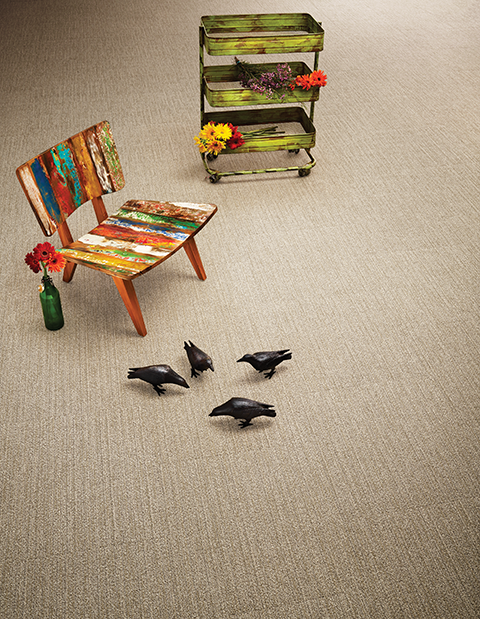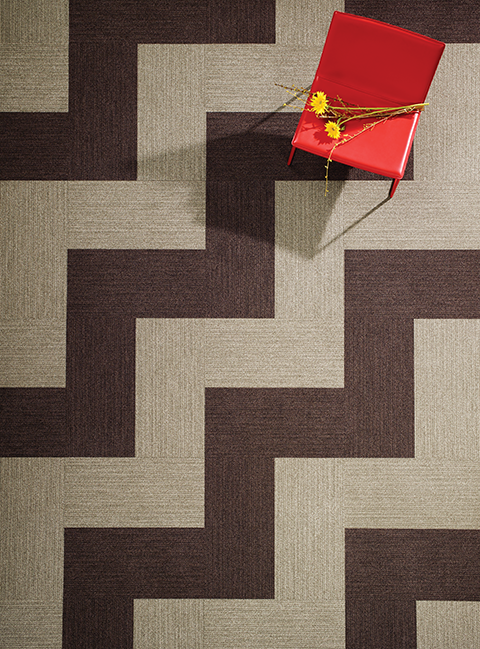
However, it is important to note the instructions for some specific styles may exceed the basic minimum requirements set forth in the CRI Installation Standard. As mentioned, carpet tile seams will never be invisible—they are usually most noticeable on the day of installation. Seams become increasingly less visible with routine vacuuming and foot traffic. Manufacturers go to great lengths to determine how a particular style should be installed to help maximize its appearance in all standard color combinations. The various styles and tile sizes make it extremely important for the installer to know whether the preferred installation layout for a particular style is monolithic, brick, ashlar, quarter-turn, or herringbone.
Recommended installation layouts are included on the identifying labels affixed to the tile boxes or included as an individual paper insert in each container. They can also be usually found on the manufacturer’s website. Not only should specifiers validate the product and method, the installation company should do the same prior
to installation.

Standard installation methods
Figure 1 provides a list of industry-wide methods used to install modular carpet. The top row is plank tile (457 x 914 mm [18 x 36 in.]) and the bottom row represents square tile (610 x 610 mm [24 x 24 in.]). Manufacturers should recommend the best method for each style based on the color, pattern, and construction of the product. Most companies keep the installation direction consistent by stamping an arrow on the backing as illustrated below.
The most commonly used installation methods used in the carpet industry are:
- ashlar: all arrows should point in the same direction with the tile seam displaced by half a tile in the length direction;
- herringbone: arrows should appear to be interwoven and point in two different directions, creating a herringbone pattern;
- brick: all arrows should point in the same direction with the tile seam displaced by half a tile in the width direction;
- parquet: doubled tile arrows should point the same direction in both the length and width directions;
- monolithic: all arrows should point in the same direction (also referred to as ‘broadloom,’ this is one of the most popular methods; it keeps the design/pattern consistent);
- quarter-drop: tiles are turned 90-degrees to one another with the tile seam displaced by half a tile;
- quarter-turn: tiles are turned 90-degrees to one another (also referred to as ‘checkerboard’ or ‘tessellated’); and
- random: tiles installed without regard to direction and orientation.

Depending on the method, the most efficient way to begin an installation is to start in the corner of the room and work away from there. In certain instances, as with a bold pattern, one may find the need to mark off a room, find the center point, and start laying the tiles from there.
Recommendations
Most modular carpet manufacturers develop recommended installation methods according to their individual designs and product line. The following is step-by-step information on the process of how some manufacturers adopt the best practices of modular carpet installation methods specific to their products.
Some styles allow for various installation layouts. Others have only one or two recommended layout methods to assure an acceptable aesthetic for the client. This is not to say a client cannot install modular carpet in a non-recommended method, but the chances of unacceptable appearance or visually poor seam appearance is a likely by-product of such decisions.
How do carpet manufacturers develop recommended installation methods according to their specific brand/designs of carpet tiles?





This looks like the carpet in my school and the office where I work. I never knew that it was called modular carpet or that it comes in individual squares. Maybe this type of installation would be a good idea for my basement.
That’s good to hear that some manufacturers tailor their installation methods based on their specific products. My husband and I are looking into getting all new carpet installed, but we definitely want to get the best quality available. We’ll definitely have to ask around to find someone that seems to really know what they are doing. Thank you for this information.
Modular carpet has it’s uses for sure but I’ve never been a huge fan. It’s interesting to see how many issues you could run into. Thanks so much for sharing.
I had no clue that that kind of carpet in work places is called modular carpet and it’s installed in tiles! That is very cool to think about. I would love to see it installed one day. I agree with the article, the key to success is being educated and knowing the techniques! If people take their time and know what they’re doing, then things should work out well!
Hello, Bob Reince
thanks for sharing about carpet installation strategy
Flooring is the important part of your home and many people prefer different kinds of flooring and if you select the carpet floor then it can give the contemporary look. For carpet installation you should first prepare the room, then select the shape and size of the material. Another important point is you should select the best color of the carpet as this can give attractive looks to your home. It is better you can hire a professional contractor.